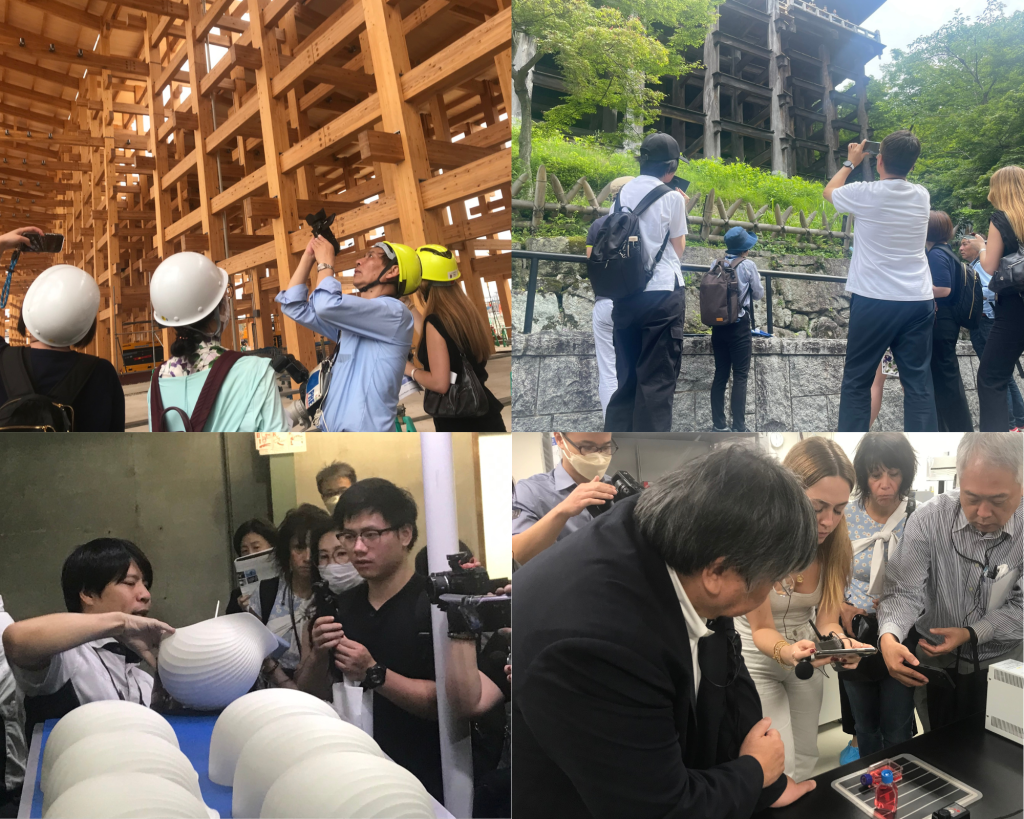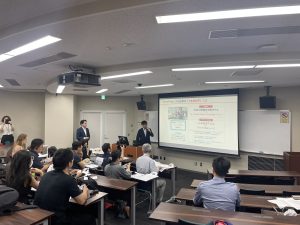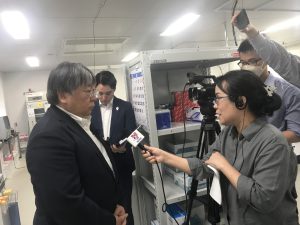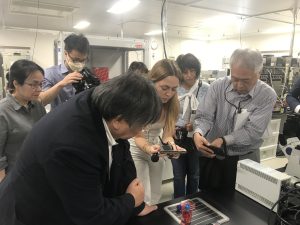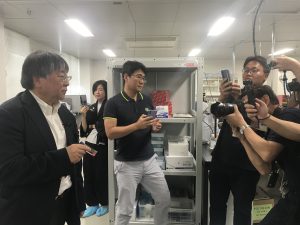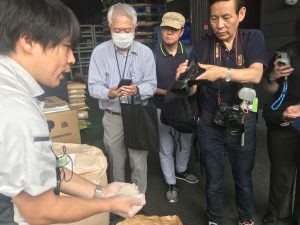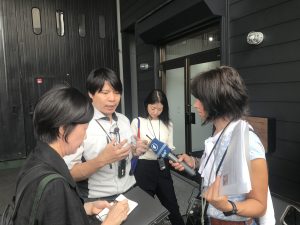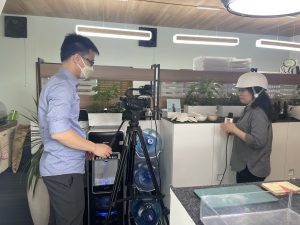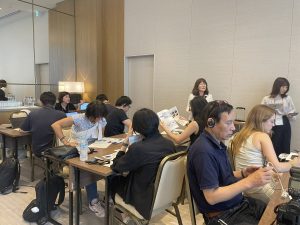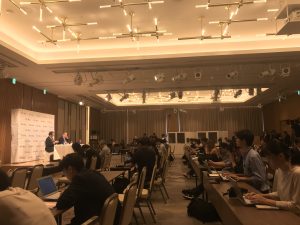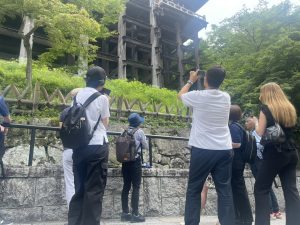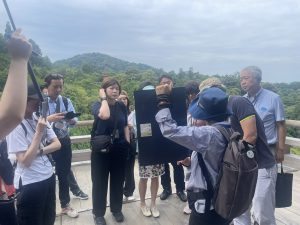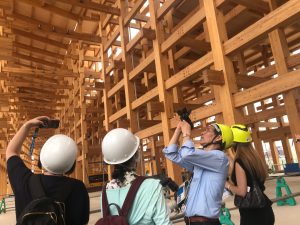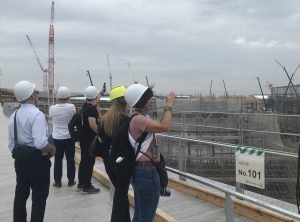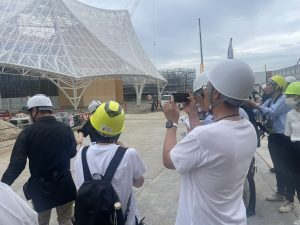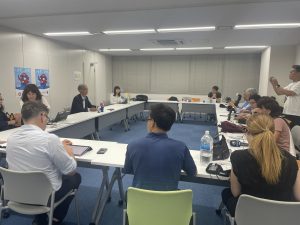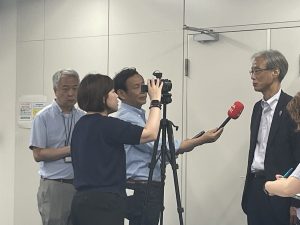実施日 : 2024年06月26日(水) - 27日(木)
Report: Expo 2025 Osaka, Kansai, Japan Press Tour
投稿日 : 2024年08月15日
For 184 days, from 13 April to 13 October, 2025, Expo 2025 Osaka, Kansai, Japan will be held on the Yumeshima artificial island in Osaka City. This will be the third World Expo to be held in Japan, after the 1970 Osaka Expo and the 2005 Aichi Expo, and its theme is “Designing Future Society for Our Lives.” With armed conflicts underway throughout the world and the recent COVID-19 global pandemic, we must consider the nature of “life.” The meaning behind the theme of this Expo is “Coming together as a world to bring about a sustainable society in which each individual can think about what kind of life they want and utilize their full potential.”
Over 160 countries and regions and 9 international organizations have stated they will participate, and they will all come together and make various exhibitions about Designing Future Society for Our Lives. With less than a year until the Expo begins and construction of the venue well under way, the FPCJ held a press tour for foreign journalists in Japan. The press tour visited the Expo site where the Grand Ring is under construction and two pavilions, and heard about the state of preparations and significance of holding the Expo from officials with the Japan Association for the 2025 World Exposition. The tour also had an early look at cutting-edge technology that will be exhibited at the Expo, and visited Kiyomizu-dera Temple in Kyoto to learn more about the traditional Japanese wooden construction techniques being used in the construction of the Grand Ring, the symbol of the Expo site.
A total of eleven journalists participated in the tour, from nine media organizations based out of Brazil, China, Germany, Hong Kong, South Korea, Spain, Taiwan, and Vietnam.
*This tour was sponsored by the Japan Association for the 2025 World Exposition and planned and operated by the FPCJ.
*For more details on the tour stops, see the press tour notice.
[Day 1]
<Living Heart Model (iPS Heart)/Interview with Dr. SAWA Yoshiki, Professor Emeritus of Osaka University>
First, the journalists heard from Pasona Group Inc. Managing Executive Officer ITO Masato about the concept, theme, and intentions behind the PASONA NATUREVERSE pavilion where a “living heart model” (or “iPS heart”) will be displayed. They then heard from the developer of the living heart model, Osaka University Professor Emeritus Dr. SAWA Yoshiki, a pioneer in regenerative medicine using iPS cells, about the possibilities of regenerative medicine using cardiomyocyte sheets and why he developed the living heart model. The tour had a chance to see cardiomyocyte sheets gently beating in a culture, and a miniature prototype of the living heart model, which the journalists filmed and photographed with great interest. The journalists asked numerous questions in a lively Q&A session, asking about whether similar research on regenerative medicine was being carried out in other countries, how many days it would take to build the living heart model, and what the professor feelings were the first time he saw a cardiomyocyte sheet
moving.
<Shellmet by Koushi Chemical Industry Co., Ltd.>
The tour also covered the Shellmet, a helmet developed that reuses discarded scallop shells in order to contribute to making a sustainable society. In addition to hearing about the background of the project and Shelltec, the new material used in the helmets made by combining scallop shells with waste plastic, from Mr. NAMBARA Tetsuya, who was in charge of development, the tour also heard about what led to the Shellmets being the official safety helmets of the Expo. At the workshop, the journalists also had the opportunity to handle as well as film and photograph powder made from scallop shells and the new Shelltec material, followed by seeing how Shellmets are made and trying on a newly made Shellmet. The journalists asked questions about the unique initiatives and properties of the Shellmet, asking whether it was more expensive than other helmets and why it had a wave pattern.
<International Participants Meeting 2024 Summer>
After arriving at the venue for the International Participants Meeting, an official from the Japan Association for the 2025 World Exposition gave an overview of the Expo, the state of its preparations, and the policies for holding the Expo. The journalists asked questions about the current state of preparations and the Expo’s operating policies. Later, the journalists visited the booths of participating local governments, businesses, and organizations on their own, where they could be seen listening intently to the representatives at those booths. At the end, the tour also joined the joint press conference held at the end of the two-day International Participants Meeting.
[Day 2]
<Kiyomizu-dera Temple>
FUJIMOTO Sou, who designed the Grand Ring, the symbol of the Expo site, has commented that the Ring “is an effort to combine tradition and the future with wooden construction using the nuki method, reminiscent of the stage of Kiyomizu-dera Temple in Kyoto.” To see the traditional nuki method of construction, the tour visited Kiyomizu-dera Temple. The journalists saw the temple while listening to a guide’s explanation of its history and buildings. This was followed by them filming and photographing from multiple angles the stage of Kiyomizu-dera Temple, which was made using the nuki method used for the Grand Ring, while hearing a detailed explanation of how the stage was made. The journalists asked questions such as why the nuki method was earthquake resistant, and about the type and quantity of lumber used to make the stage.
<Expo 2025, Osaka, Kansai, Japan Site>
First, the tour received an explanation of the overall makeup of the venue, the positioning of the pavilions, and the structure of the Grand Ring from official with the Japan Association for the 2025 World Exposition. Afterwards, the journalists filmed and photographed the Grand Ring from a spot with a view of the whole site, and headed towards the venue where construction and preparations were under way. Once there, first they visited the Osaka Healthcare Pavilion “Nest for Reborn,” with its exterior reminiscent of a bird’s nest, where the journalists heard from an official with the Expo 2025 Osaka Pavilion Association about the pavilion’s theme, concept, unique structure, and exhibitions, as well as filmed and photographed the exterior. Next, the journalists walked through the interior of the nearly completed Grand Ring taking photos and videos, followed by seeing the Expo venue as a whole from atop the Grand Ring, getting a close look at the venue and the state of preparations. The journalists made comments such as “I’m surprised at how much construction of the Grand Ring has progressed since one year ago,” and, “I heard that the Grand Ring had a circumference of 2 km, but it is still bigger than I imagined." After the Grand Ring, the tour walked through the venue to the Pasona Group’s PASONA NATUREVERSE pavilion, with a spiral design based on an ammonite. The tour heard from Pasona Group Inc. Managing Executive Officer ITO Masato about the pavilion’s concept, main theme, and the reason for its unique design. In addition to the exterior of the pavilion, the tour also had the opportunity to see inside, where construction is progressing.
The journalists seemed very pleased to have had this valuable opportunity to see the Grand Ring and two pavilions close up before completion.
<Interview with Mr. TAKASHINA Jun, Japan Association for the 2025 World Exposition Deputy Secretary General>
The journalists heard from Deputy Secretary General TAKASHINA Jun about the latest state of preparations for the Expo and how, with COVID-19, Russia’s invasion of Ukraine, and the Israel-Gaza conflict putting the world at risk of division, the value of the Osaka, Kansai, Japan Expo was greater than ever, and had an important role to play in returning the world from being divided to being connected. He also expressed his hopes that, by having millions of people from over 160 countries around the world coming together in person over 184 days, the Expo could be a place to grasp the current issues facing the world and discuss ideas and technologies that could be solutions to these global issues. In the following Q&A session, the journalists asked about whether he thought the Expo would have a ripple effect on the Japanese economy, what the reasons were behind the reported withdrawals of countries from building Type A pavilions, whether the Grand Ring would be reused after the Expo ended, and how many tickets had been sold. Multiple media organizations also held individual interviews with the deputy secretary general.
◆Below are some of the reports based on this tour.
Vietnam News Agency (Vietnam)
「Nhật Bản tung ra mũ bảo hiểm Shellmet làm từ vỏ sò và nhựa tái chế」 (Video: 29:30~31:30) (1 July)
「Nhật Bản giới thiệu mô hình “trái tim sống” đầu tiên trên thế giới」 (Video: 22:35~24:15) (3 July)
「Grand Ring – Công trình biểu tượng của EXPO 2025」 (Video: 17:30~19:55) (5 July)
Agencia EFE (Spain)
(*The link has been reposted on Swiss Info.)
「Un templo milenario japonés inspira el recinto de la Expo Universal 2025」 (28 June)
「Láminas de células creadas en Japón podrían regenerar corazones con insuficiencia」 (2 July)
ARD German Radio (Germany) *Already broadcasted
「Rückzieher und hohe Kosten_Expo 2025 in Japan」 (6 July)
Valor Econômico (Brazil) *Print only
「Uma Expo em tempos turbulentos」 (19 July)

